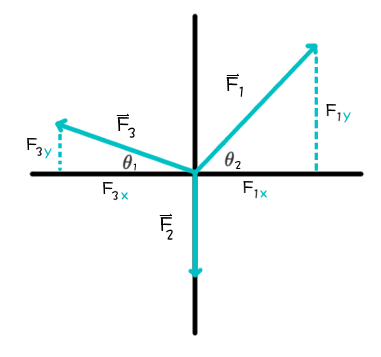Forces in Equilibrium?
Three horizontal forces of magnitudes #(F ) N# , #63N# and #25N# act at #O# , the origin of the x-axis and y-axis.
The forces are in equilibrium. The force of magnitude #(F) N# makes an angle #theta# anticlockwise with the positive #x# -axis. The force of magnitude #63N# acts along the negative #y# -axis. The force of magnitude #25N# acts at #tan^-1(0.75)# clockwise from the negative #x# -axis. Find the value of #F# and the value of #tantheta# .
Three horizontal forces of magnitudes
The forces are in equilibrium. The force of magnitude
1 Answer
Explanation:
We can use trigonometry, vector decomposition, and Newton's second law to find the desired values.
We have the following information:
#|->F_2=63"N"# #|->F_3=25"N"# #|->theta_1=arctan(0.75)#
We want to find
Here is a diagram:

The forces are in a state of dynamic equilibrium, meaning that the acceleration is zero. Therefore, we can sum the parallel and perpendicular components of the three forces as follows:
#(1)color(darkblue)(sumF_x=F_(1x)-F_(3x)=ma_x=0)#
#(2)color(darkblue)(sumF_y=F_(1y)+F_(3y)-F_2=ma_y=0)#
Let's look at
Using trigonometry, we can find the parallel (x, horizontal) and perpendicular (y, vertical) components of
#sin(theta)="opposite"/"hypotenuse"#
#=>sin(theta_1)=(F_(3y))/F_3#
#=>F_(3y)=F_3sin(theta_1)#
#=>=25sin(arctan(0.75))#
#=>=15#
#:.color(darkblue)(F_(3y)=15"N")#
Similarly, we can find
#F_(3x)=F_3cos(theta_1)#
#=25cos(arctan(0.75))#
#=20#
#:.color(darkblue)(F_(3x)=20"N")#
Then, using equation
#F_(1x)=F_(3x)#
#=>F_1cos(theta_2)=20#
#color(darkblue)(F_1=20/cos(theta_2))#
Using equation
#F_(1y)=F_2-F_(3y)#
#=>F_1sin(theta_2)=63-15#
#=>color(darkblue)(F_1=48/sin(theta_2))#
We now have two equations for
#20/cos(theta_2)=48/sin(theta_2)#
#=>sin(theta_2)/cos(theta_2)=48/20#
#=>tan(theta_2)=12/5#
#=>theta_2=arctan(12/5)#
#=>color(darkblue)(theta_2=67.38^o)#
We can put this value back into either of our equations for
#F_1=20/cos(theta_2)#
#=>=20/(cos(67.38^o))#
#=>=52#
Finally, we can find
#=>tan(67.38^o)=color(crimson)(2.40)#

